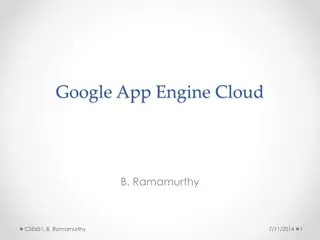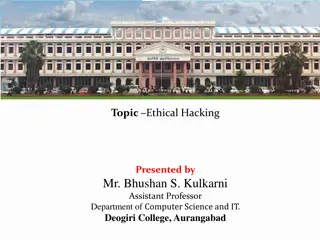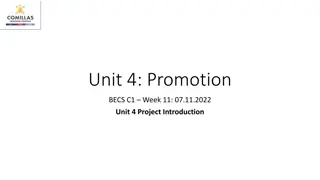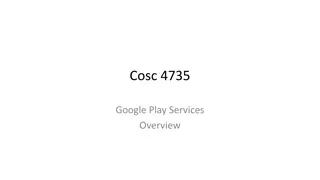Google Hacking Techniques Overview
The Google search engine offers various features that can be used for both beneficial and malicious purposes. Learn about Google search techniques, advanced operators, hacking techniques, automated scanning, and more.
Download Presentation

Please find below an Image/Link to download the presentation.
The content on the website is provided AS IS for your information and personal use only. It may not be sold, licensed, or shared on other websites without obtaining consent from the author.If you encounter any issues during the download, it is possible that the publisher has removed the file from their server.
You are allowed to download the files provided on this website for personal or commercial use, subject to the condition that they are used lawfully. All files are the property of their respective owners.
The content on the website is provided AS IS for your information and personal use only. It may not be sold, licensed, or shared on other websites without obtaining consent from the author.
E N D
Presentation Transcript
GOOGLE HACKING Defiana Arnaldy, M.Si deff_arnaldy@yahoo.com 1
Overview GOOGLE SEARCH TECHNIQUES GOOGLE ADVANCED OPERATORS GOOGLE HACKING TECHNIQUES ABOUT GOOGLE AUTOMATED SCANNING OTHER GOOGLE STUFF 2
GOOGLE SEARCH TECHNIQUES The Google search engine found at www.google.com offers many different features including language and document translation, web, image, newsgroups, catalog and news searches and more These features offer obvious benefits to even the most uninitiated web surfer, but these same features allow for far more nefarious possibilities to the most malicious Internet users including hackers, computer criminals, identity thieves and even terrorists 3
Google web interface The Google search engine is fantastically easy to use. Despite the simplicity, it is very important to have a firm grasp of these basic techniques in order to fully comprehend the more advanced uses. The most basic Google search can involve a single word entered into the search page found at www.google.com. 4
As shown in Figure 1. I have entered the word Sardine. into the search screen. Figure 1 shows many of the options available from the www.google.com front page. 6
Basic search techniques Simple word searches Basic Google searches, as I have already presented, consist of one or more words entered without any quotations or the use of special keywords. Examples: peanut butter butter peanut olive oil popeye 8
+ searches When supplying a list of search terms, Google automatically tries to find every word in the list of terms, making the Boolean operator AND redundant Some search engines may use the plus sign as a way of signifying a Boolean AND Google uses the plus sign in a different fashion. When Google receives a basic search request that contains a very common word like the , how , or where the word will often times be removed from the query as shown in Figure 6 9
In order to force Google to include a common word, precede the search term with a plus (+) sign. Do not use a space between the plus sign and the search term. For example, the following searches produce slightly different results: where quick brown fox +where quick brown fox 11
- searches Excluding a term from a search query is as simple as placing a minus sign (-) before the term. Do not use a space between the minus sign and the search term. For example, the following searches produce slightly different results: quick brown fox quick brown fox 12
Phrase Searches In order to search for a phrase, supply the phrase surrounded by double- quotes. Examples: the quick brown fox liberty and justice for all harry met sally 13
Mixed searches Mixed searches can involve both phrases and individual terms. Example: macintosh "microsoft office This search will only return results that include the phrase Microsoft office , and the term macintosh. 14
Google advanced operators Google allows the use of certain operators to help refine searches. The use of advanced operators is very simple as long as attention is given to the syntax. The basic format is: operator:search_term Notice that there is no space between the operator, the colon and the search term. If a space is used after a colon, Google will display an error message. If a space is used before the colon, Google will use your intended operator as a search term 15
Some advanced operators can be used as a standalone query. For example cache:www.google.com can be submitted to Google as a valid search query The site operator, by contrast, must be used along with a search term, such as site:www.google.com help 16
site: find web pages on a specific web site This advanced operator instructs Google to restrict a search to a specific web site or domain. When using this operator, an addition search argument is required Example This query will return results from harvard.edu that include the term tuition anywhere on the page 18
filetype: search only within files of a specific type. This operator instructs Google to search only within the text of a particular type of file. This operator requires an additional search argument. Example: This query searches for the word endometriosis within standard text documents. There should be no period (.) before the filetype and no space around the colon following the word filetype 19
It is important to note that Google only claims to be able to search within certain types of files Google can search within most files that present as plain text For example, Google can easily find a word within a file of type txt , html or php since the output of these files in a typical web browser window is textual The current list of files that Google can search is listed in the filetype FAQ located at http://www.google.com/help/faq_filetypes.html. 20
Google can search within the following file types: Adobe Portable Document Format (pdf) Adobe PostScript (ps) Lotus 1-2-3 (wk1, wk2, wk3, wk4, wk5, wki, wks, wku) Lotus WordPro (lwp) MacWrite (mw) Microsoft Excel (xls) Microsoft PowerPoint (ppt) Microsoft Word (doc) Microsoft Works (wks, wps, wdb) Microsoft Write (wri) Rich Text Format (rtf) Text (ans, txt) 21
link: search within links The hyperlink is one of the cornerstones of the Internet. A hyperlink is a selectable connection from one web page to another. Most often, these links appear as underlined text but they can appear as images, video or any other type of multimedia content. 22
This advanced operator instructs Google to search within hyperlinks for a search term. This operator requires no other search arguments. Example This query query would display web pages that link to Apple.com s main page. This special operator is somewhat limited in that the link must appear exactly as entered in the search query. The above query would not www.apple.com/ipod, for example. find pages that link to 23
cache: display Googles cached version of a page This operator displays the version of a web page as it appeared when Google crawled the site. This operator requires no other search arguments. Example: These queries would display the cached version of Johnny s web page. Note that both of these queries return the same result 24
intitle: search within the title of a document This operator instructs Google to search for a term within the title of a document. Most web browsers display the title of a document on the top title bar of the browser window. This operator requires no other search arguments. Example: This query would only display pages that contained the word gandalf in the title 25
A derivative of this operator, allintitle works in a similar fashion. Example: This query finds both the words gandalf and silmarillion in the title of a page. The allintitle operator instructs Google to find every subsequent word in the query only in the title of the page. This is equivalent to a string of individual intitle searches. 26
inurl: search within the URL of a page This operator instructs Google to search only within the URL, or web address of a document. This operator requires no other search arguments. Example: This query would display pages with the word amidala inside the web addres. One returned result, http://www.yarwood.org/kell/amidala/ contains the word amidala as the name of a directory 27
The word can appear anywhere within the web address, including the name of the site or the name of a file. A derivative of this operator, allinurl works in a similar fashion. Example: This query finds both the words amidala and gallery in the URL of a page. The allinurl operator instructs Google to find every subsequent word in the query only in the URL of the page. This is equivalent to a string of individual inurl searches. 28
About Googles URL syntax The advanced Google user often times streamlines the search process by use of the Google toolbar or through direct use of Google URL s. For example, consider the URL generated by the web search for sardine: 29
First, notice that the base URL for a Google search is The question mark denotes the end of the URL and the beginning of the arguments to the search program. The & symbol separates arguments The URL presented to the user may vary depending on many factors including whether or not the search was submitted via the toolbar, the native language of the user, etc. 30
Arguments to the Google search program are well documented at http://www.google.com/apis. The arguments found in the above URL are as follows: 31
Most of the arguments in this URL can be omitted, making the URL much more concise. For example, the above URL can be shortened to making the URL much more concise 32
Additional search terms can be appended to the URL with the plus sign. For example, to search for sardine along with peanut and butter consider using this URL: Since simplified Google URLs are simple to read and portable, they are often used as a way to represent a Google search. 33
Google (and many other web-based programs) must represent special characters like quotation marks in a URL with a hexadecimal number preceded by a percent (%) sign in order to follow the http URL standard. For example, a search for the quick brown fox (paying special attention to the quotation marks) is represented as 34
In that example, a double quote is displayed as 22 and spaces are replaced by plus (+) signs. Google does not exclude overly common words from phrase searches. Overly common words are automatically included when enclosed in double-quotes. 35
Domain searches using the site operator The site operator can be expanded to search out entire domains. For example: This query searches every web site in the .gov domain for the word secret 37
Notice that the site operator works on addresses in reverse. For example, Google expects the site operator to be used like this: 38
Google would not necessarily expect the site operator to be used like this: The reason for this is simple. Cia and www are not valid top-level domain names. This means that as of this writing, Internet names may not end in cia or www . However sending unexpected queries like these are part of a competent Google hacker s arsenal as we explore in the googleturds section. 39
How this technique can be used 1. Journalists, snoops and busybodies in general can use this technique to find interesting dirt about a group of websites owned by organizations such as a government or non-profit organization. Remember that top-level domain names are often very descriptive and can include interesting groups such as: the U.S. Government (.gov or .us) Hackers searching for targets. If a hacker harbors a grudge against a specific country or organization, he can use this type of search to find sensitive targets. 2. 40
Finding googleturds using the site operator Googleturds, are little dirty pieces of Google waste These search results seem to have stemmed from typos Google found while crawling a web page. Example: Neither of these queries are valid according to the loose rules of the site operator, since they do not end in valid top-level domain names. However, these queries produce interesting results as shown in Figure 7. 41
How this technique can be used Hackers investigating a target can use munged site values based on the target s name to dig up Google pages (and subsequently potential sensitive data) that may not be available to Google searches using the valid site operator Example: A hacker is interested in sensitive information about ABCD Corporation, located on the web at www.ABCD.com. Using a query like site:ABCD may find mistyped links (http://www.abcd instead of http://www.abcd.com) containing interesting information. 43
Site mapping: More about the site operator Mapping the contents of a web server via Google is simple. Consider the following query: This query searches for the word Microsoft restricting the search to the www.microsoft.com web site. How many pages on the Microsoft web server contain the word Microsoft? According to Google, all of them! Remember that Google searches not only the content of a page, but the title and URL as well. 44
The word Microsoft appears in the URL of every page on www.microsoft.com. With one single query, an attacker gains a rundown of every web page on a site cached by Google. There are some exceptions to this rule. 45
If a link on the Microsoft web page points back to the IP address of the Microsoft web server, Google will cache that page as belonging to the IP address, not the www.micorosft.com web server. In this special case, an attacker would simply alter the query, replacing the word Microsoft with the IP address(es) of the Microsoft web server. 46
How this technique can be used This technique makes it very simple for any interested party to get a complete rundown of a website s structure without ever visiting the website directly. Since Google searches occur on Google s servers, it stands to reason that only Google has a record of that search. 47
How this technique can be used The process of viewing cached pages from Google can also be safe as long as the Google hacker takes special care not to allow his browser to load linked content such as images from that cached page. For a competent attacker, this is a trivial exercise. Simply put, Google allows for a great deal of target reconnaissance that results in little or no exposure for the attacker. 48
Finding Directory listings Directory listings provide a list of files and directories in a browser window instead of the typical text-and graphics mix generally associated with web pages. Figure 8 shows a typical directory listing. 49























